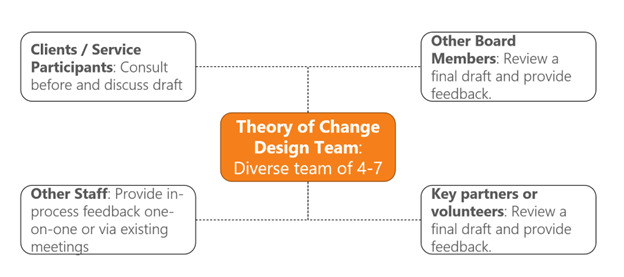Crafting a Theory of Change, Part 1: Where to Begin
5/10/24 / Paul Collier

Is your organization grappling with evaluations and indicators that don’t adequately tell your impact story? Having a unified Theory of Change for your organization can help you solve this problem.
In short, a Theory of Change (ToC in the rest of this blog) is both a process and a product that describes who your organization serves, what your organization does to serve them, and what lasting impact you intend to help your community achieve. We’ve found that every organization has an implicit ToC, and most people can recount at least one story to illustrate how their organization makes an impact. But few organizations have a ToC that is written down and shared regularly, and even fewer take a structured approach to testing their ToC over time.
A strong ToC expressed in writing is a critical aspect of any social mission organization’s strategy. While drafting takes time and effort, in this blog series we outline an engaging, five-step process that we use to help organizations draft a ToC efficiently, and even have some fun while doing so. For this first blog, we will explore how to foster equitable participation in your ToC drafting process, and how to identify your target population and your problem-to-solve.
Fostering Equitable Participation
Defining a ToC is a collaborative process. To begin, establish a “ToC Design Committee” comprised of 4-7 people. In practice, these are typically organization staff members familiar with different program areas, and have different levels of experience and authority within an organization. This group could also include a representative from the population your organization works with, a board member, or a key partner or volunteer.

With this committee established, drafting can begin. This is where an outside facilitator can be valuable, as it is useful to have an impartial party that can guide your committee through brainstorming exercises and help you examine which ideas are most essential to your ToC. In our practice we setup a series of four 90-minute workshops, exploring the key concepts a ToC articulates:
- Workshop 1: Target Population and Problem-to-Solve
- Workshop 2: Activities, Outputs, and Outcomes; Visual Representation
- Workshop 3: Inputs, Assumptions
- Workshop 4: Share-out and Action Plan
After each workshop, our task as facilitators is to translate the brainstormed ideas into writing, seek out research or data to support the ideas identified by the group, and identify critical questions for further discussion in the next workshop.
Exploring Your Population and Problem-to-Solve
To start defining a ToC, we typically begin by exploring who an organization currently serves, and whether they intend to expand that in the future. Note that some organizations define their population(s) in terms of individuals (this is common for direct-service organizations), while other define their population as organizations (a collective impact initiative or a co-working space might take this approach). Regardless, three aspects are important to consider:
- Demographics: Unchanging characteristics of a population, such as geographic location, age, ethnicity, and income.
- Psychographics: Commonly held attitudes or preferences that impact how these individuals engage with a service provider.
- Indicators of need, interest, or risk: Some organizations are set up to serve a subset of their population with a particularly high or low level of risk.
Once the design committee is clear about their organization’s target population(s), we explore what problem(s) the organization is trying to help this population address. So often organizations overestimate how much other constituents (and even their own staff) know about the problem they’re working towards solving. Your ToC should define the problem(s) your organization seeks to solve, the scale of the problem(s), causes of the problem(s) that led us to the present day, and consequences for our broader community if nobody acts on the problem(s). Great theories of change will reference existing research and population level data to add credibility to their problem statement, and illustrate the importance of timely action.
What’s Next…
Here we have covered the critical steps to start defining your organization’s Theory of Change. Are you ready for more? Continue exploring the remaining steps of the process in part two.
If you’d like to talk in more depth about the nuances of creating a cohesive, actionable Theory of Change for your organization, feel free to contact us.
